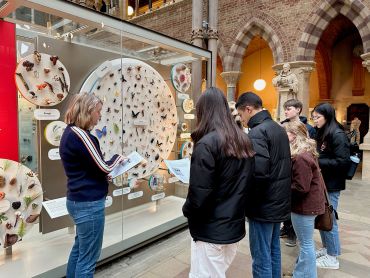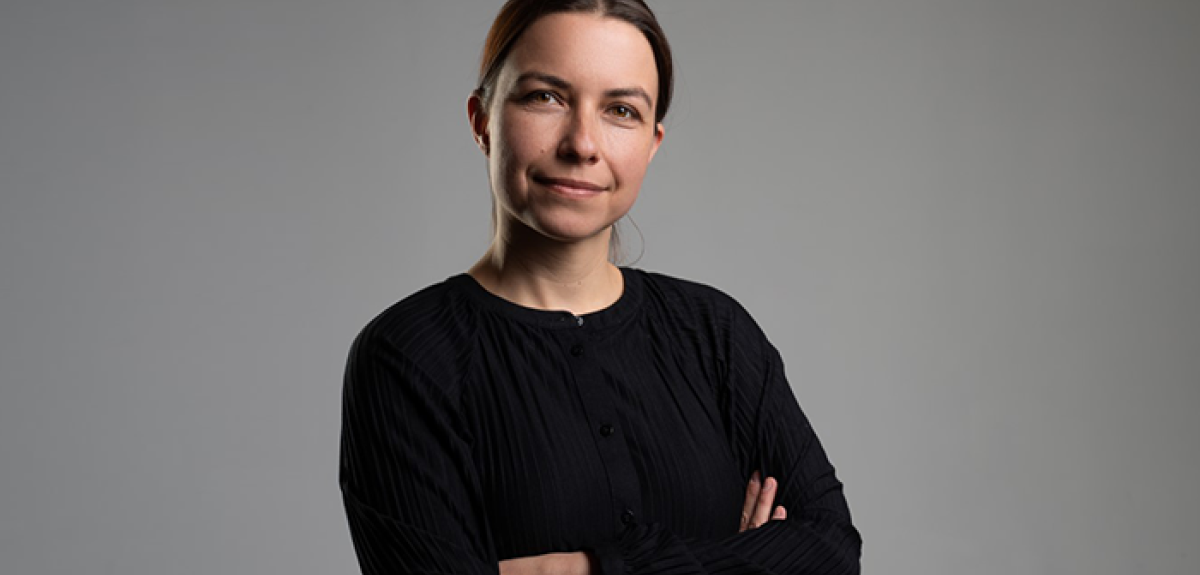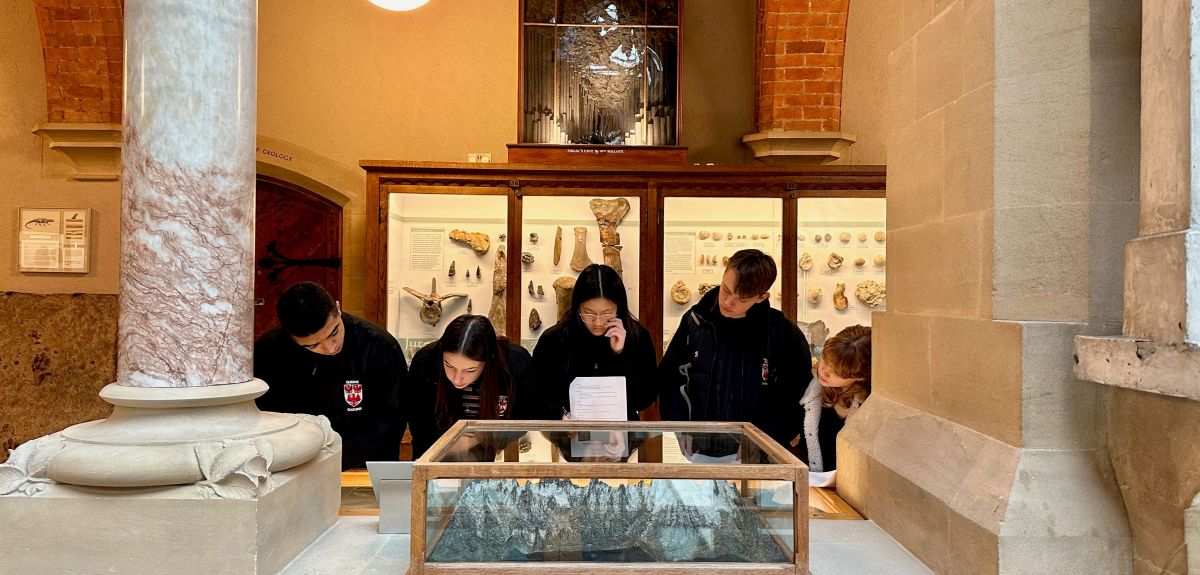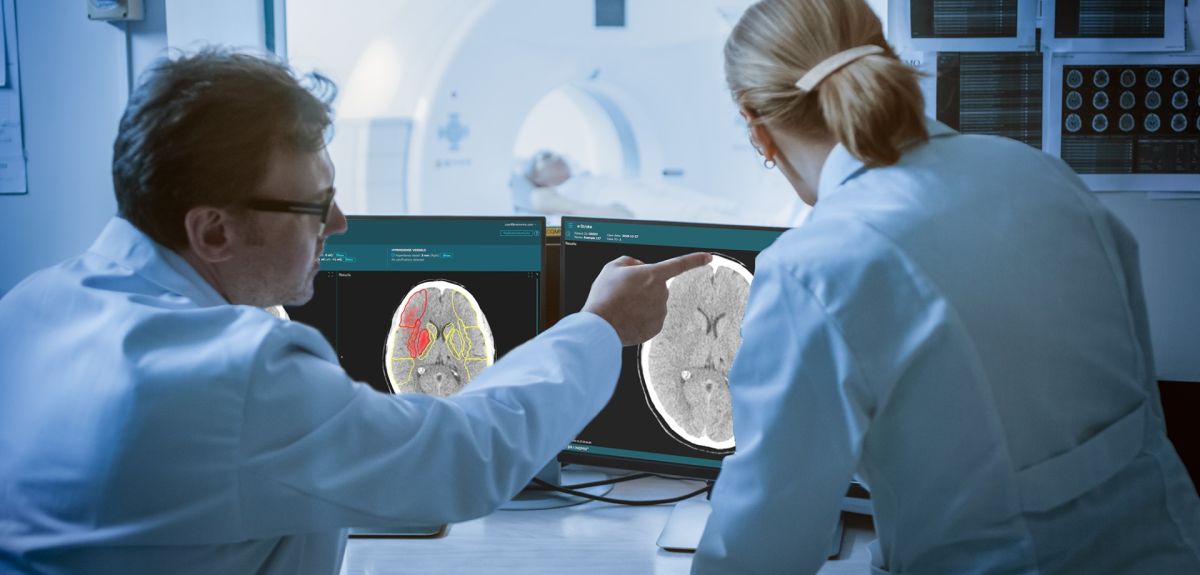Features
The world’s most powerful computer hasn’t yet been built – but we have the blueprint, says the team behind Oxford spinout Quantum Dynamics.
Meanwhile, Chris Ballance, co-founder of spinout Oxford Ionics, says ‘quantum computing is already solving complex computing test cases in seconds – solutions that would otherwise take thousands of years to find.’
Following decades of pioneering research and development – much of it carried out at the University of Oxford –some of the world’s most innovative companies have integrated their technology into existing systems with excellent results.
Ask a quantum scientist at the University of Oxford for a helpful analogy and they may direct you towards the Bodleian library: a classical computer would look through each book in turn to find the hidden golden ticket, potentially taking thousands of years; an advanced quantum computer could simply open every book at once.
From drug discovery and climate prediction to ultra-powerful AI models and next-generation cryptology and cybersecurity, the potential applications of quantum computing are near-limitless. We’re not there yet, but a host of quantum-based companies with roots in Oxford academia are driving us towards a world of viable, scalable and functional quantum computers – and making sure we’ll be safe when we get there.
With the UK government’s recent announcement to inject £45 million into funding quantum computing research, the future is looking brighter for getting these technologies out into the real world.
Let’s meet some Oxford spinouts leading the charge.
Quantum Motion Technologies
Research suggests that, as with today’s smartphones and computers, silicon is the ideal material from which to make qubits – the basic units of quantum information and the building blocks of quantum computers. Formed in 2017 by Professor Simon Benjamin of Oxford’s Department of Materials and Professor John Morton at UCL, Quantum Motion is developing scalable architecture to take us beyond the current small, error-prone quantum computers.
PQShield
Any news article about the benefits of quantum computing is also likely to highlight a threat: the potential of quantum technology to shatter today’s encryption techniques (imagine a computer able to guess all possible password combinations at once). PQShield, spun out of Oxford’s Mathematical Institute by Dr Ali El Kaafarani, uses sophisticated maths to develop secure, world-leading ‘post-quantum’ cryptosystems. The team has the largest assembly of post-quantum crypto specialists in the world, servicing the whole supply chain.
Orca Computing
Making quantum computing a practical reality is what drives the team at Orca, spun out of research developed at the University of Oxford in 2019. The company is developing scalable quantum architecture using photonics – the manipulation of light – as its basis. In the short-term, that means creating usable technology derived from repurposing telecoms for quantum. This enables the team to build massive-scale information densities without resorting to impossible numbers of components. In the longer-term, Orca’s approach means error-corrected quantum computers with truly transformative potential. Dr Richard Murray, CEO and co-founder, explains: ‘Thanks to our drive towards delivering commercially realistic solutions, we are addressing the consumption of quantum.’
Oxford Ionics
Co-founded in 2019 by Dr Chris Ballance of Oxford’s Department of Physics, Oxford Ionics’ qubits are composed of individual atoms – the universe’s closest approximation to a perfect quantum system. These high-performance qubits have won Oxford Ionics a £6m contract to supply a quantum computer to the UK’s National Quantum Computing Centre in Harwell, Oxfordshire, with the aim of developing new applications.
QuantrolOx
To build practical quantum computers, scientists will need millions of physical qubits working in constant harmony – a big challenge to scaling up. QuantrolOx’s AI software automates the ‘tuning’ process, allowing quicker feedback and better performance. The company, co-founded by Professor Andrew Briggs of Oxford’s Department of Materials, envisions a world where every quantum computer will be fully automated.
Oxford Quantum Circuits
Oxford Quantum Circuits’ quantum computer is the only one of its kind commercially available in the UK. The company, founded by Dr Peter Leek of Oxford’s Department of Physics and today led by founding CEO Ilana Wisby, is driving quantum technology out of the lab and directly to customers’ fingertips, enabling breakthroughs in areas such as predictive medicine, climate change and AI algorithms. Ilana’s vision is for ten machines in ten countries within ten years..
Other innovations in processing power
As quantum computing continues to progress – but with the timeline for adoption unclear – innovators in Oxford are also looking for ways to turbocharge today’s computing technology.
Salience Labs
The speed of AI computation doubles every few months, outpacing standard semiconductor technologies. Salience Labs, a joint spinout of Oxford and Münster universities, is building photon-based – rather than electron-based – solutions to allow us to keep up with exponential AI innovation and the vast amounts of information that require processing in the 21st century.
Lumai
AI’s ability to analyse vast datasets at rapid pace is one of its big selling points. Trained models can produce diagnoses from a patient’s medical images or help insurance companies detect fraud. Oxford spinout Lumai works at the nexus of 3D optics and machine learning to provide an energy-efficient AI processor that delivers computation speeds 1,000 times faster than traditional electronics, enabling AI inference to move to the next level.
Machine Discovery
Harnessing its proprietary neural network technology, Machine Discovery makes complex numerical simulations quicker and cheaper. The Oxford Department of Physics spinout aims to provide its customers with all the benefits of machine learning – without the years of AI research. Its ‘Discovery Platform’ technology allows users to describe their problem and let the software find the solution.
Kelsey Doerksen is a DPhil student in Autonomous Intelligent Machines and Systems at the Department of Computer Science, and the President of the Oxford Womxn in Computer Science Society. She is also a Giga Data Science Fellow at UNICEF and a Visiting Researcher at European Space Agency.
There is enormous potential for artificial intelligence (AI) tools to benefit society; from early detection of diseases, to natural disaster response, to helping us write succinct emails. But these technologies need to be viewed under a critical lens to ensure that we are building tools to help, and not harm society.
When we are thinking about reducing bias in AI models, we need to start with the datasets we are using to teach them. AI models are being trained on datasets which we know have systematically left minorities out of the picture; resulting in data that lacks diverse representation of gender identities, sexual orientations, and race, among others. AI can be a powerful tool to mitigate human-induced bias because it is a data-driven approach to decision making, but if the data it is using has biases, this becomes an issue. For example, we have seen generative AI adopting stereotypes and biases when generating images of certain professions that we typically associated with men or women in the past.
In addition to bias mitigation from a data perspective, it is critical that the diversity of users of an AI product are represented at the development stage. Improving gender representation in AI and Computer Science (CS) is something I am very passionate about, and being a part of the Oxford Womxn in Computer Science Society (OxWoCS) for the past three years has been transformative to my experience as a woman in the field.
The success of the society speaks for itself, we have grown to 250+ members with over 750 people on our mailing list, providing academic, career and social opportunities to the CS community at Oxford University across all levels of study and research. My experience leading OxWoCS as the 2023-24 President has been one of the highlights of my DPhil. It has been incredibly rewarding to connect with so many women in the field who are equally as passionate about their research as they are about building a welcoming and safe community for gender minorities in the space.
My hopes for the future of women in the fields of AI and CS is that we continue to champion and advocate for one another to build stronger communities that celebrate the diversity of experiences that we bring to the table.
* 'Artificial intelligence and gender equality: how can we make AI a force for inclusion?' was the topic of a panel discussion co-hosted by the Vice-Chancellor Professor Irene Tracey CBE, FRS, FMedSci and Professor Tim Soutphommasane, Chief Diversity Officer on 6 March 2024 ahead of International Women's Day.
As we mark International Women’s Day, Professor Ekaterina Hertog spoke to us about AI, the increase of automation in the home and its impact on women and wider society. She considers whether AI and greater automation in the home have the potential to help alleviate some societal inequalities and lead to greater inclusion for women and under-represented groups in the workplace and wider society.
Can you tell us a little about your current research on AI, automation in the home and its significance for women as we celebrate IWD 2024?
Katya: My research lies at the intersection of digital sociology and family sociology. I lead an ESRC-funded Domestic AI project at the Oxford Internet Institute, University of Oxford, that explores the potential of new gadgets and apps to free up time now locked into unpaid housework and care work. Together with my team, we also investigate how willing people are to introduce these technologies into their private lives.
Smart, digitally connected household robots are becoming more common. Examples include cooking robots, such as Thermomix popular in Germany and several other European countries, as well as robotic vacuum cleaners, window cleaners, and lawnmowers. These technologies can save people time currently locked into domestic labour and free them up to do other things. At the same time, these gadgets still need some level of human input, whether tidying up before setting the robot vacuum cleaner to work or getting all the ingredients ready for the cooking robot.
Technology certainly has the potential to transform domestic work, but there are several barriers to full-scale adoption, both at an individual level and societal level.
Looking at this issue from an individual perspective, in a research paper* my team and I published last year we find that male and female experts imagine the usefulness and marketability of domestic automation technologies quite differently, especially in a highly gender unequal society like Japan. We found that female experts were more excited by the potential of the technology to take over domestic tasks, while male experts were more likely to point out that many domestic tasks would be quite expensive and therefore domestic automation will not be of interest to consumers. Female experts agreed with male experts that automating domestic work is not cheap but were more likely to maintain that such automation will be of interest to consumers even at a high price. A number of female experts we spoke to highlighted that they would be keen adopters of robots or other technologies that would help them with household chores.
Do you think that technology can help bring about greater equality for women in society, thinking about your own research in particular?
Katya: Technology is often talked about as our saviour, but it has limitations. It can be a useful tool to combat social inequalities if adopted thoughtfully, but it can also easily amplify inequalities rather than reduce them. Many social problems that cannot be solved through technology, or at least not through technology alone.
Let’s take gender inequality in domestic labour as an example and consider the role technology might play in helping to alleviate some of those inequalities with some practical examples. First, as I’ve already touched on, technology is to a significant extent shaped by the imaginaries of those behind its development and the most potentially useful technologies may not get developed or reach the market for social rather than technical reasons. If the people behind the development of the robots or apps that could help in the homes have a particular view of domestic work, because maybe they are able to outsource much of it, that will influence which technologies are developed and make it to the market and which never see the light of day.
Second, technologies have the potential to transform tasks, but this transformation by itself may not be enough to bring about substantial social change. Let’s consider the case of a washing machine. Washing machines made the task of keeping laundry clean a lot easier and less time-consuming. They were powerless, however, to challenge the social roles which expected women to do the lion share of domestic work. Moreover, as the widespread adoption of washing machines led to an increase of hygiene standards, much of the time freed up by the washing machines was immediately taken by domestic tasks around laundry washing, such as folding and ironing, that became more time consuming with the increased frequency of washing clothes. Finally, if technologies that help with domestic work come with a significant price tag, they may reduce gender inequality, but only in richer households.
Technology lives within the broader ecosystem of family and society, influencing how individuals engage with technology and what risks and opportunities they are exposed to. With the examples above I highlight the fact that technologies can help solve prevailing social problems, including gender inequality, but for this to happen we need thoughtful and principled design effort as well as broader attention to social barriers to gender equality and consideration for policy solutions going beyond technology.
We also need to think about our values and how these may influence the solutions we opt for. For example, do we want a kitchen robot to save us time on cooking family meals or do we want our jobs to be more flexible so all family members can spend more time cooking and share the household chores equally?
Your research could have a big impact for women, do you expect tech and AI to improve equality for women?
Katya: We need to think about how these AI tools are designed and who makes the decisions about what kind of technology we’re going to invest in. Tech sector tends to be male-dominated, with women and other under-represented groups having limited input in the solutions that make it to market.
We see decisions about AI technologies in the home being made by people who historically and on average, even today, do less domestic work and whose lives are less structured by the different types of domestic work as the burden still tends to fall more on women, despite some of the progress that’s been made with men contributing more in the home.
Technology is certainly a tool that we can use to improve our everyday lives, but these bigger structural issues need to be addressed before we see real long-lasting change.
What can be done to inspire inclusion in the way AI technologies are developed?
Katya: A lot of people are sounding the alarm about the way AI is developing so quickly without sufficient checks and balances in place and often with limited input from the groups most affected by its adoption. It’s been said that AI often simply reproduces existing inequalities rather than breaks the mould and I agree with that to a degree.
The transformative impact of AI depends to a large extent on the design decisions we’re making now and our ability to plan strategically for the outcomes we want to see which truly reflect a diverse society.
Breaking down social barriers and reducing inequalities inherent in AI technologies won’t happen by itself. It's about several factors, design, regulation, active strategic planning and decision-making, and optimising the tech for multiple goals, whether profit, diversity, or well-being, although it’s usually all of these things to some extent.
What do you hope will be different for women in the age of AI and what concerns you?
Katya: The technologies that get designed and funded are the ones that predominately feature on the mental maps of the people in power at the helm of these big tech companies, which disproportionately tend to be white men. Looking ahead, I’d like to see greater diversity and inclusion at top, which is then reflected in the AI technologies that get launched to the market. It’s not just about including women’s experiences, which is very important, it’s also about including the voices and experiences of other groups that are currently under-represented.
I’d also like to see more work done around measuring the consequences of implementation of AI technologies and their impact on women and under-represented groups. All too often there is a rush to launch the latest innovative AI tool in a media fanfare and just put it out there, without the software developers building in any type of tracking facility to see what the consequences of the technology are and the effects it has on people’s lives. For example, facial recognition software used in education was better at authenticating white rather than non-white faces which racial inequalities to test taking, but that only got picked up once a large number of children were negatively affected.
Often, any issues with the technology only get raised when it has been adopted at scale, and by then it is often costly and time consuming to make changes to design to address observed bias or minimise any other unintended consequences of implementation further down the line. Having a process which mandates at least some level of participatory design, a pilot stage, and regular post-implementation checks would be important to achieving a more inclusive future in the age of AI.
And finally, what advice would you give to other women in the tech industry this IWD?
Katya: I’ve learned a lot about how AI can exacerbate and generate inequalities, both from my research in the field of domestic AI and my own experience juggling my professional life with my personal life. I’ve been fortunate in that before having a family, I was able to see some of the data around how much time is spent on domestic work once you have children, which prompted me to have a very explicit conversation with my partner about how we were going to navigate balancing our working lives with our family lives once we had children.
I would encourage other female researchers just starting in this male-dominated field to think very strategically about their values and what they want to achieve in their professional and personal lives. Think about the work-life balance and how you will achieve sharing domestic and paid work responsibilities equally within your relationship, especially after having children.
Professor Ekaterina Hertog is Associate Professor in AI and Society at the Oxford Internet Institute and the Institute for Ethics In AI, in association with Wadham College.
Find out more about Professor Hertog’s current research project: Domestic AI
Download her latest peer-reviewed papers:
The future of unpaid work: Estimating the effects of automation on time spent on housework and care work in Japan and the UK published by the journal Technological Forecasting and Social Change
Authors: Ekaterina Hertog, Setsuya Fukuda, Rikiya Matsukura, Nobuko Nagase, Vili Lehdonvirta
‘The future(s) of unpaid work: How susceptible do experts from different backgrounds think the domestic sphere is to automation?’ published by the journal Plos One
Authors: Vili Lehdonvirta, Lulu P. Shi, Ekaterina Hertog, Nobuko Nagase,Yuji Ohta
‘It’s not her fault’: Trust through anthropomorphism among young adult Amazon Alexa users
Published by the journal Convergence
Authors: Elizabeth Fetterolf and Ekaterina Hertog
 Oxford University's Museum of Natural History
Oxford University's Museum of Natural HistoryIt’s the start of a new term and as the doors to Oxford’s Museum of Natural History open, five first-year undergraduate biology students arrive for their weekly Biology tutorial.
Today they are meeting Professor Lindsay Turnbull, a tutor at The Queen’s College where the students all live and study. She is also Professor of Plant Ecology in the University’s Department of Biology and author of ‘Biology: The Whole Story’, published last year.
Founded in 1860 as the centre for scientific study at Oxford, the Museum holds the University’s internationally significant collections of geological and zoological specimens. It’s the perfect place to think about the animal kingdom – the purpose of this week’s tutorial – and the different phyla or groups that make it up.
On the Museum’s ground floor, in front of eye-catching displays of colourful butterflies, spiders and fungi, parades of mammals, and replicas of dinosaur skeletons, Professor Turnbull outlines the plan for the next hour. The group is given a quiz based around key areas of study for the term and the students split into two teams and head off to find the answers within the collections.
 Professor Lindsay Turnbull with her tutorial group
Professor Lindsay Turnbull with her tutorial group“They allow tutors to interact regularly with students and to monitor their development closely and are different from other forms of university teaching because of their personal nature and the way that you can fine-tune your teaching to suit different groups. They encourage students to talk about their work and to share their ideas. Ideally, they also allow students to gain in confidence.”
 The group exploring the Museum's collections
The group exploring the Museum's collectionsFor fellow student Austin, tutorials offer a more fun and conversational experience than a lecture: “What I enjoy the most is breaking down a big problem gradually as a group, bouncing off each other's ideas to solve something that you couldn't sit down and do in an hour.”
The five Biology students meet once a week, usually at The Queen’s College, but Professor Turnbull’s tutorial locations are varied. Last term they hunted for tiny tardigrades (or moss piglets) in the University’s Botanic Gardens; “although we completely failed to find them!” she says.
Professor Turnbull believes it’s important that the students get out and about and takes her group to gain a greater familiarity with the natural world: “In the practical tutorials I’m trying to achieve a few things. First, to get to know them better, because there’s no pressure on them to perform. Second, to give them exposure to natural history. Some of our students have incredible knowledge about nature, and others have very little. It can be a real advantage to have some of that knowledge, so it’s good to share it around.”
 One of the many display cases at the Museum
One of the many display cases at the Museum
“Being able to see the animal models and fossils helps me to better visualise what we are discussing” says Eunice, “rather than trying to describe the organisms in words or through pictures on a slideshow”.
Fellow Queen’s College student Oliver, says, “Being out and about, and interacting with things that we have learnt about in lectures is immensely valuable. I think it grounds you and reminds you that what you are learning about is real and affects creatures in their day-to-day lives.”
Reconvening in the Museum’s café, the five students come back together to share and discuss what they’ve found, from a platyhelminthes – a flatworm that can grow to 12 metres and can regrow any body part – to squirting sea cucumbers.
“The session in the museum this year was great” says Professor Turnbull, “I love the museum and I’m keen for students to use it more. By showing them what’s there, I hope they’ll be more likely to return on their own and use it for themselves.”
This year, around 100,000 people in the UK will have a stroke. AI algorithms developed by a University of Oxford spinout company are ensuring that more stroke patients will receive better care and outcomes.
It’s no coincidence that the best-known acronym for spotting signs of a stroke urges FAST action. Every second counts, not least for the clinicians making crucial decisions about diagnosis and treatment.
Brainomix is a digital health company which spun out of the University’s preclinical stroke lab, part of the Nuffield Department of Clinical Neurosciences, in 2010. It was co-founded by Dr Michalis Papadakis, who now works full-time as the company's CEO.
In 2023 we were delighted to receive FDA approval to take our e-ASPECTS tool to the US, where more than 800,000 people suffer a stroke each year. This tool, part of the Brainomix 360 package of AI technologies, supports physicians who are making time-sensitive, critical decisions around transfer and treatment, strengthening networks and facilitating an improved stroke service.
Dr Michalis Papadakis, founder and CEO, Brainomix
The company has developed state-of-the-art AI algorithms to help doctors make quick, accurate decisions for patients. Its e-Stroke platform analyses images from simple CT scans, providing detailed real-time information – available to view remotely – on the extent and nature of damage to the brain.
The technology is effective: studies have shown that implementing e-Stroke reduces arrival-to-discharge times by more than one hour, as well as tripling the number of stroke patients going on to achieve functional independence.
The e-Stroke platform – the most comprehensive tool of its kind – has been adopted by more than 30 healthcare systems worldwide and has raised over £30m in public and private funding. A patient is scanned using e-Stroke every five minutes, with results available in just 60 seconds.
Brainomix has now developed similar AI-powered imaging platforms for lung disease and cancer. The company is regularly showcased by government as a leader in the health data revolution.
This year, around 100,000 people in the UK will have a stroke. That’s one every five minutes. Globally, the annual number of strokes is estimated to be upwards of 12 million, making it one of the world’s leading causes of death and disability. Brainomix is ensuring that an increasing number of those people will receive better care and better outcomes – a shining example of the potential for academic spinouts to translate innovative research into real-world impact that can benefit patients and healthcare providers.
- ‹ previous
- 3 of 248
- next ›





 A blueprint for sustainability: Building new circular battery economies to power the future
A blueprint for sustainability: Building new circular battery economies to power the future Oxford citizen science project helps improve detection of antibiotic resistance
Oxford citizen science project helps improve detection of antibiotic resistance The Oxford students at the forefront of the fight against microbial resistance
The Oxford students at the forefront of the fight against microbial resistance  The hidden cost of AI: In conversation with Professor Mark Graham
The hidden cost of AI: In conversation with Professor Mark Graham  Astrophoria Foundation Year: Dr Jo Begbie reflects on the programme’s first year
Astrophoria Foundation Year: Dr Jo Begbie reflects on the programme’s first year World Malaria Day 2024: an interview with Professor Philippe Guerin
World Malaria Day 2024: an interview with Professor Philippe Guerin From health policies to clinical practice, research on mental and brain health influences many areas of public life
From health policies to clinical practice, research on mental and brain health influences many areas of public life From research to action: How the Young Lives project is helping to protect girls from child marriage
From research to action: How the Young Lives project is helping to protect girls from child marriage  Can we truly align AI with human values? - Q&A with Brian Christian
Can we truly align AI with human values? - Q&A with Brian Christian